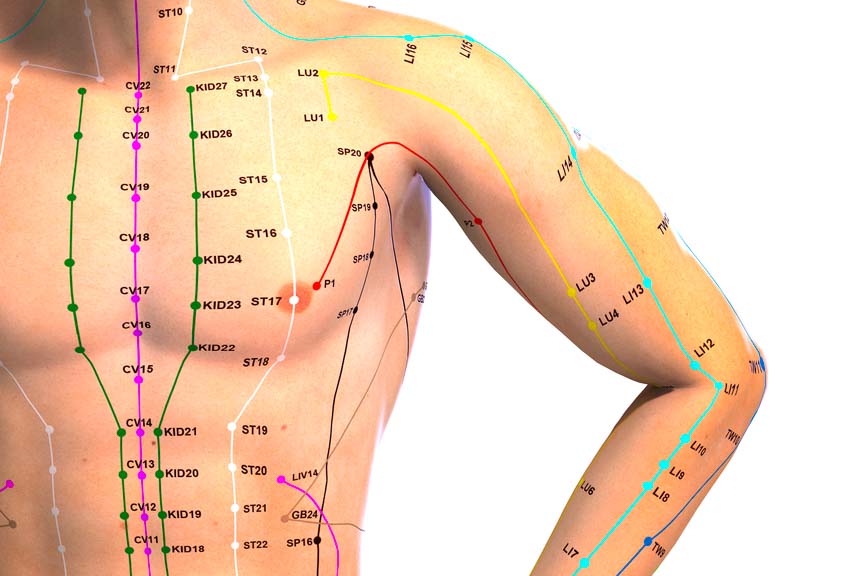
Acupuncture plus herbs increases the total effective rate of medications for the treatment of pneumonia. Researchers from Hanzhong Railway Central Hospital combined traditional Chinese medicine (TCM) treatment with drug therapy in a controlled clinical trial. Two groups were compared. The control group received standard drug therapy. The treatment group received acupuncture and herbs in addition to identical drug therapy treatment protocols administered to the control group. The control group had an 88.33% total effective rate. The combined treatment group had a 98.33% total effective rate. The addition of TCM therapy increased the total effective rate by 10% (p<0.05). [1]
The following parameters were used to measure patient outcomes: disappearance time of symptoms and signs, length of hospital stay, white blood cell (WBC) counts, procalcitonin (PCT) levels, hemorheology and immunity indices, and adverse effect rates. WBCs (leukocytes) are immune system cells active in fighting infections. PCT is a peptide precursor that becomes increased in response to bacterial infections. The hemorheology indexes used in the study included fibrinogen, hematocrit, and plasma viscosity levels. CD4+/CD8+ and natural killer (NK) cell activity quantified immunity system parameters in this investigation.
Disappearance time of symptoms and signs was significantly faster and the length of required hospital stays was shorter in the combined treatment group (p<0.01). Both groups had improvements of WBC, PCT, and indexes of hemorheology and immunity, with the acupuncture combined treatment group having significantly greater positive patient outcome rates (p<0.05). The adverse reaction rate in the combined treatment group was 1.67% and 3.34% in the control group. The data indicates that the addition of acupuncture to standard drug therapy protocols increases the effective rate while simultaneously lowering the adverse effect rate.
Sun et al. employed the following study design. A total of 120 patients were treated and evaluated. Patients were diagnosed with severe pneumonia between February 2014 and February 2017. They were randomly divided into two groups, with 60 patients in each group. Control group patients were given standard drug therapy for controlling infections and correcting fluid and electrolyte imbalances. The treatment group received acupuncture, an herbal formula called Qing Fei Zhu Yu (Heat-Clearing and Stasis-Expelling) decoction, and identical drug therapy protocols.
The statistical breakdown for each randomized group was as follows. The treatment group was comprised of 32 males and 28 females. The average age in the treatment group was 56.79 years. The control group was comprised of 35 males and 25 females. The average age in the treatment group was 56.73 years. There were no significant statistical differences in gender, age, and other demographic data relevant to patient outcome measures for patients admitted to the study.
Treatment
The primary acupoints selected for the treatment of pneumonia were the following:
- LU1 (Zhongfu)
- LI16 (Jugu)
- BL13 (Feishu)
- BL12 (Fengmen)
Additional secondary acupoints were added based on symptom presentation. For high fever, the following acupoints were added:
- GV14 (Dazhui)
- LI11 (Quchi)
For chest pain, the following acupoint was added:
- PC6 (Neiguan)
For abdominal distention, the following acupoint was added:
- ST36 (Zusanli)
After disinfection of the acupoint sites, a 25 mm disposable filiform needle was inserted into each acupoint with a high needle entry speed. After arrival of qi, the Ping Bu Ping Xie (mild tonifying and attenuating) manipulation technique was applied. A 30-minute needle retention time was observed. One acupuncture session was conducted daily, for 7 consecutive days. The Qing Fei Zhu Yu decoction used in the study was comprised of the following ingredients:
- Shui Niu Jiao 30 g
- Zhe Bei Mu 30 g
- Dan Shen 20 g
- Gua Lou Ren 20 g
- Sang Bai Pi 20 g
- Huang Qin 15 g
- Dan Nan Xing 15 g
- Chi Shao 15 g
- Di Long 15 g
- Chuan Bei Mu 6 g
- Shuang Da Huang 6 g
- Gan Cao 6 g
The ingredients were decocted in water. The herbal medicine was ingested 2 times per day, 200 ml each time, for 7 days. After treatment, the treatment efficacy for each patient was categorized into 1 of 3 tiers:
- Recovery: complete absence of symptoms and signs.
- Effective: improvement in symptoms and signs.
- Not effective: no improvement in symptoms and signs.
Summary
The data shows that acupuncture plus herbs benefits patients with pneumonia. TCM treatment protocols increase the clinical efficacy of pharmaceutical drug interventions and reduces the adverse effect rate. This study indicates that an integrative approach to patient care increases positive patient outcome rates.
Reference:
1. Sun DZ, Ma YB. Qingfei Zhuyu Decoction Combined with Acupuncture in Treatment of Severe Pneumonia: Study of Clinical Efficacy and Action Mechanism [J]. Information on Traditional Chinese Medicine, 2018,04:114-117.
"herbs" - Google News
March 02, 2020 at 04:35AM
https://ift.tt/2Trn50s
Acupuncture And Herbs Found Effective For Pneumonia Relief - HealthCMi
"herbs" - Google News
https://ift.tt/2QrhQgM
Shoes Man Tutorial
Pos News Update
Meme Update
Korean Entertainment News
Japan News Update
Bagikan Berita Ini















0 Response to "Acupuncture And Herbs Found Effective For Pneumonia Relief - HealthCMi"
Post a Comment